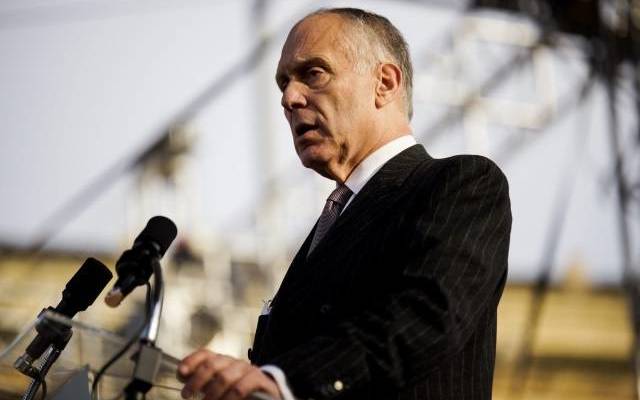Remembering the Holocaust is about reminding ourselves how quickly verbal racism and anti-Semitism can turn into acts of murder.
On 29 and 30 September 1941, in less than 36 hours, SS units shot dead more than 33,000 Jews at a ravine near Kiev. Since then, the name ‘Babi Yar’ is a synonym for one of the worst massacres ever committed in the history of mankind.
In the two weeks following this atrocity, a further 18,000 men, women and children were murdered at that site. For the Nazi regime, the massacre was a test case for the implementation of the plan to exterminate European Jewry, a plan that was formally approved a few months later at the Wannsee Conference.
Babi Yar had been prepared meticulously. It involved not only special SS killing units, but also regular German army units, as well as allied Ukrainian groups.All of them were an integral part in the planning and execution of this massacre.
On 28 September 1941, notices were posted across Kiev calling on the city’s Jews to present themselves the following day with identification documents, money and valuables, and warm clothing, in order to be evacuated. Anyone refusing to follow the order was to be executed.
The previous day, more than 100,000 rounds of ammunition from Wehrmacht stocks had arrived in Kiev. Nonetheless, the Germans expected that only a few thousand of the remaining 50,000 Jews (the remainder had fled before the German troops arrived) in the city would show up, but more than 30,000 did. They did so in the hope to be resettled and thus survive.
However, the Germans had something else in mind.
After being stripped of all their belongings and clothes, thousands were led into the ravine, which is located next to an old Jewish cemetery, and shot dead.
The Babi Yar survivor Dina Pronicheva remembered the scene: “We were surrounded by fascists with submachine guns, Ukrainian policemen, and ferocious dogs who were ready to tear a human being to pieces. And then, I could not leave my mother alone. I embraced her, burst into tears but was unable to leave her. Mother pushed me away and yelled ‘Hurry!’”
The corpses stacked up in layers; the scene must have been unspeakably gruesome. But the slaughter continued for 36 hours. At the same time, the killers kept exact records. In an “event report” to the SS leadership in Berlin dated 1 October 1941, 33,771 Jews were reported to have been liquidated.
The mass murder went like clockwork. The Wehrmacht, the regular German army, also played along.
Less than 30 people survived the slaughter. Dina Pronicheva was one of them. She had fallen into the pit before a bullet could hit her, and after nightfall she was able to able to crawl out of the huge heap of corpses, which had already been covered with sand.
Another survivor recalled: “The bodies of old men rested on the bodies of children, who lay on the bodies of their dead mothers.”
Even for the hardened killers of the SS, what had happened at Babi Yar was too horrible to reveal to the public, and the Germans later tried to conceal their atrocious crime by forcing laborers to exhume the bodies in order to burn them. But the massacre had been too big to conceal.
Where Anti-Semitism Can Lead
More and more people question the purpose of such memorials. Others ask: Shouldn’t we rather focus on what’s happening today, in Syria, in Iraq, and in many other places around the world?
Has Holocaust remembrance become dispensible? Have the Germans, and the world, learned the lessons of the murder of six million Jews? Do we still need such official acts of remembrance? We do.
To be clear: Remembering these crimes is not a ritual, or even a way to put an entire people in the dock.
Remembering the Holocaust is about reminding ourselves how quickly verbal racism and anti-Semitism can turn into acts of murder. It took the Nazis only a few years to turn people into well-functioning serial killers. The fanatical hatred of Jews with which they had been imbued worked very quickly.
Where the history of the Holocaust is not taught in schools, or where the Holocaust is even questioned by government officials, indoctrinating people with hatred against Jews and other minorities is much easier.
Very few people are now left who can still tell us about what they went through during World War II. Therefore, we need official acts of remembrance because they send an important signal.
The remembrance of the Shoah and other crimes must remain a key element in the education of young people. Of course, it’s not necessary to focus only on the negative aspects of one’s past, and the positive ones deserve to be highlighted.
And yet, in a nation or a society that is conscious of its past crimes, it is much harder for fanatics to incite people to commit mass murder.
Last year, the 70th anniversary of the liberation of Auschwitz-Birkenau was marked. There was huge media interest, and it was probably the biggest act of Holocaust remembrance ever held. This was important.
It may be inconvenient to state, but not everybody has learned the lessons of this horrible time. Some even try to glorify war criminals of that time as national heroes.
That is the reason why we need more, and not less remembrance.
It is important that we don’t consign the Holocaust to the history books and slowly forget about it.
If we do, if may come back at some stage. That, by the way, does not only apply to Germany or to Ukraine, but to all countries.
By: World Jewish Congress President Ronald S, Lauder
This op-ed was first published in the German newspaper ‘Die Welt’.
